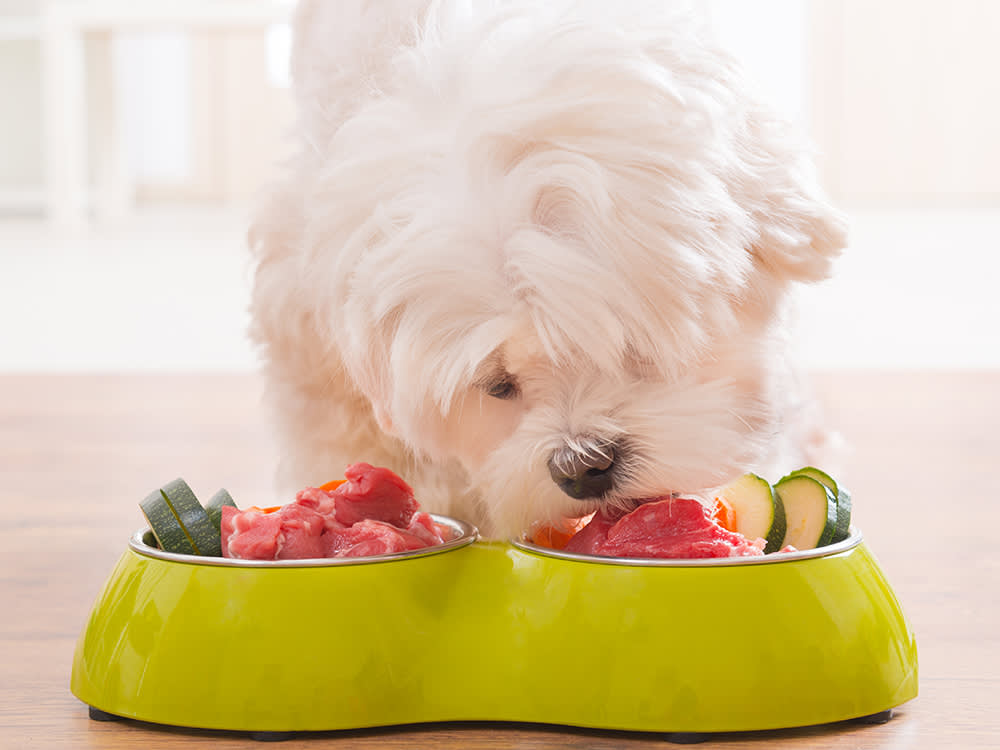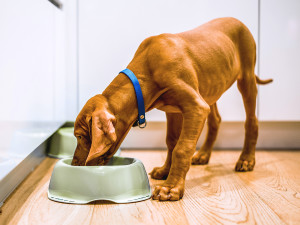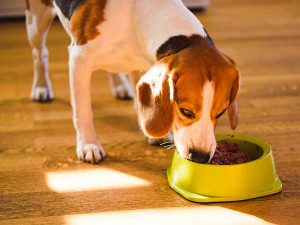The Scoop on Human-Grade Dog Food
For starters, yes, it’s good enough to eat.
There are a lot of factors to consider when picking a dog food for your pup. Like, a lotopens in new tab. It can be hard to separate real benefits from marketing buzzwords. High on the list of hype-worthy options are human-grade dog foods. But what does that term mean, and does it matter to your doggo? We did some digging, so you don’t have to.
What exactly is human-grade dog food?
To answer that question, we need to understand the difference between foods classified as “edible” and “inedible” (hint: it has nothing to do with how the food tastes). Edible foods use ingredients and manufacturing processes that are deemed safe for human consumption. Thus, they are known as human-grade foods. They’re highly regulated throughout every stage of the food production and distribution process to ensure their safety. Inedible foods — a.k.a. “feed-grade” foods — include ingredients not fit for humans (poultry by-products, for example) and are laxer when it comes to processing and handling. Though they’re not considered safe for human consumption, they are suitable for use in pet foods. Feed-grade isn’t inherently less safe when it comes to quality control, but it’s not regulated as closely.
Pet foods that say “human grade” on the packaging are held to a high standard. According to the Association of American Feed Control Officials (AAFCO), “for a product to be human-edible, all ingredients in the product must be human-edible, and the product must be manufactured, packed, and held in accordance with federal regulations in 21 CFR 110, Current Good Manufacturing Practice in Manufacturing, Packing, or Holding Human Food.” Human-grade pet foods come in various forms, including dehydrated, freeze-dried, fresh-cooked, or frozen.
You might also see pet foods that say they use “human-grade ingredients.” That means that some or all of the ingredients used to make the food are human-grade, but somewhere along the road from raw ingredients to finished product, they fell out of compliance as a human-grade food. An example of this would be a product that uses human-grade ingredients but is processed in a pet food manufacturing facility.
Is human-grade dog food better for my pet?
Good question. For some perspective, we turned to Ollie, a popular brand of human-grade dog food. According to Ollie’s Head of Food, Bridget Meadows, “with fresh, human-grade food, you can see exactly what whole foods are in your pup’s bowl. Focusing your dog’s diet on high-quality, whole ingredients can eliminate several health issues your dog might be struggling with, like allergies or digestive trouble. In each of Ollie’s nutritious and delicious recipes, real beef, chicken, turkey, and lamb serve as the primary sources of protein. Each recipe also comes packed with vitamin-rich fruits, leafy greens, root vegetables, and superfoods like cod liver oil and chia seeds that make it easier for pets to absorb the ingredients’ natural health benefits and live healthier lives.”
Who wouldn’t want that for their pet…but do those high-quality ingredients really make a difference? Signs point to yes. Though there haven’t been many studies comparing human-grade dog food to feed-grade kibble, the existing research is encouraging. For example, one study found that the amino acid availability (a measure of protein quality) in moderately-processed chicken was much greater than that found in rendered chicken meal (which is commonly used in feed-grade pet food). Another study revealed higher digestibility levels in human-grade dog food compared to kibble. Both of these findings point to a high nutritional value for human-grade pet food.
Let’s agree to agree that picking up poop sucks. So it stands to reason that the less you have to pick up, the better. Human-grade foods may be able to help on this front. A study opens in new tab comparing human-grade dog foods and feed-grade kibble showed that dogs on the kibble diet had to eat more than dogs fed human-grade food. And since what goes in must come out, dogs that ate kibble had a much higher volume of poop. In fact, dogs fed the human-grade food produced less than half the amount of poop as their kibble-eating counterparts.
Of course, not all human-grade pet foods are the same. When selecting any diet for your pet, you want to make sure you’re buying from a reputable company that understands your pet’s nutritional needs. Look for companies that work with a board-certified veterinary nutritionist — or better yet, employ one full time — to develop their recipes.
How does human-grade dog food compare to raw or home-cooked dog food?
Raw food is a popular trend in pet food that claims to mimic the eating habits of dogs in the wild. This begs the question: is it better to feed your pet a diet that resembles food found in the wild or food found cooking on your stove at home? “Fresh, human-grade dog food contains the right ingredients for the total nutrition of your dog and is gently cooked to be safe for both people and pets to handle,” says Meadows. “The cooking process also makes the food easier for your pet to digest and absorb all the great nutrients found in each ingredient.” Since exposing pets and people to dangerous bacteria is one of the main concerns with raw diets, eliminating that risk certainly feels like one for the “win” column.
Wondering if you can just cook your own human-grade dog food at home? You sure can. However, getting the right balance of nutrients is tricky, so you’d want to work with a veterinary nutritionist to ensure you’re meeting your pet’s nutritional needs. But you might find that reputable human-grade pet food brands offer the same benefits of homemade diets without all the work on your end.
Companies such as Ollieopens in new tab, The Farmer’s Dogopens in new tab, Nom Nomopens in new tab, and PetPlateopens in new tab (to name a few) not only work with nutritionists to tailor their recipes to your pup but also offer additional conveniences. These include pre-portioned meals that are easy to store and serve, home delivery, and subscription options. And let’s face it — the less time you spend thinking about, making, or buying your dog’s food, the more time you have to hang out with your pal.
Disclaimer alert: This article is here to share information. But, much like pineapple on pizza, the topic may be controversial. Meaning, not all vets or pet professionals agree. Because every pet is a unique weirdo with specific needs. So, don’t take this as fact or medical advice. Talk things over with your vet when making decisions, and use your best judgment (about both your pet’s health and pizza toppings).




